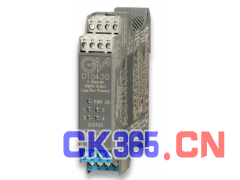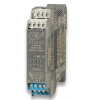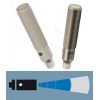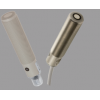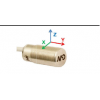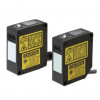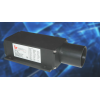of Electronic Equipments in the Cabinet
All electronic equipment operate using electrical power And dissipate part of it into heat which is generally removed by the surrounding
ambient air And determines an increase in the operating temperature. High operating temperatures reduce their life And increase the
probability of failures according to the Arrhenius criteria, for example an operating temperature increase from 25 to 50 °C can cause a
failure rate ten times higher.
In a cabinet air circulates And removes heat by convection (natural convection cooling) or, more effectively, by forced ventilation (fans)
or even more effectively by refrigerated forced ventilation (air conditioning). Installation of electronics in cabinets restricts free air
movement And rises their internal temperature. These effects can be reduced in two concurring lines of action:
• by limiting the power dissipation And the heat produced inside the cabinet
• by encouraging air circulation (and exchange of heat) inside the cabinet
A simple way to improve air circulation is to provide sPACe between the isolators, also installing isolators in horizontally oriented DIN rail
rows with the enclosure main surfaces oriented vertically allows better air circulation inside the enclosure And significantly improves
heat exchange.
What ultimately determines the operating temperature rise inside a cabinet is the total power dissipation And the provisions available
for removing the heat with cool air (natural convectionOrforced cooling). The maximum power consumption of each type of isolator is
specified in the corresponding data sheet so by summing the power of each unit in the cabinet the total power Pmax can be easily
found. In normal operating conditions however the power dissipated by the installed equipments is not likely to be the maximum value
specified for all of them And at the same time, the value of the effective power Peff can therefore be considered smaller (typical 70 %)
than the value Pmax:
Peff ≤ Σ Pmax * 70 %
1) Closed Cabinets with Natural Convection
Closed cabinets are preferred in dustyOrharsh environments where they offer a better equipment protection but their heat / power
dissipation capability is modest. Heat is removed by air flowing internally And exchanged with the walls of the cabinet, the calculation of
the maximum allowed power dissipation in this type of cabinet is:
Pmax = Δt * S * K
where: Pmax [W] maximum allowed power dissipation
Δt [°C] maximum allowed temperature rise
S [m²] free heat emitting surface of the cabinet
K [W/m² * °C] thermal conductivity coefficient (K=5.5 for painted steel sheets)
As an example a cabinet sized 600x600 mm And 2000 mm high has a temperature rise of 10 °C for an installed power of 250 W.
2) Open Cabinets with Natural Convection
Open cabinets must operate in clean environments, their heat / power dissipation capability is medium.
Heat is removed by air flowing through the equipment, circulating from bottom to top of cabinet (convection). Depending on the type of
engineering (freedom of cool air to enter at the bottom of the cabinet, to circulate vertically around the equipment extracting heat And to
exit at the top of the cabinet), the power dissipation improvement can be two times better than case 1.
The cabinet must be equipped with inlet And outlet louvers in the lower And upper ends of the cabinets, vertical air flow inside and
outside the cabinet must be kept free from obstacles to enhance the “chimney effect” air circulation.
As an example a cabinet sized 600x600 mm And 2000 mm high has a temperature rise of 10 °C for an installed power of 350 W.
3) Open Cabinets with Forced Ventilation
Open cabinets must operate in clean environments, their heat / power dissipation capability is high with forced ventilation
Air is forced into the louvers on the bottom of cabinet, flows through the equipments, And finally exits at the top of the cabinet, where
generally is forced by oneOrmore fans. The calculation of the required airflow is:
Q = 3.1 * Peff / Δt
where: Q [m³/h] is the required airflow
Peff [W] is the dissipated power (typical 70 % of the maximum power dissipation)
Δt [°C] is the maximum allowed temperature rise in the cabinet
As an example a cabinet sized 600x600 mm And 2000 mm high has a temperature rise of 10 °C for an installed power of 500 W.
4) Closed Cabinets with Forced Ventilation And Heat Exchanger
Closed cabinets with forced ventilation are preferred in high dissipated power And harsh environment where natural convection
cabinets cannot be used. Hot air is extracted from the cabinet by a fan, cooled by a heat exchanger (using a cooling fan with ambient
air) And forced back into the cabinet; depending on the type of engineering the improvement can reach a 5 times higher power
dissipation than in case 1.
As an example a cabinet sized 600x600 mm And 2000 mm high has a temperature rise of 10 °C for an installed power of 1000 W.
5) Air Conditioned Cabinets
Air conditioned cabinets are preferred in hot climates And /Orharsh environments.
Cabinet temperature can become equalOreven lower than the ambient temperature. A specific refrigerating systemOrthe existing air
conditioning system can be used for cabinet conditioning.
As an example a cabinet sized 600x600 mm And 2000 mm high has a temperature rise of 10 °C for an installed power of 1000 W.






公司联系方式
- 常州吉盟机电控制系统有限公司 [加为商友]

- 联系人蔡海燕(女士)
- 地区江苏-常州市
- 地址常州天宁区恒生科技园1号楼1303




